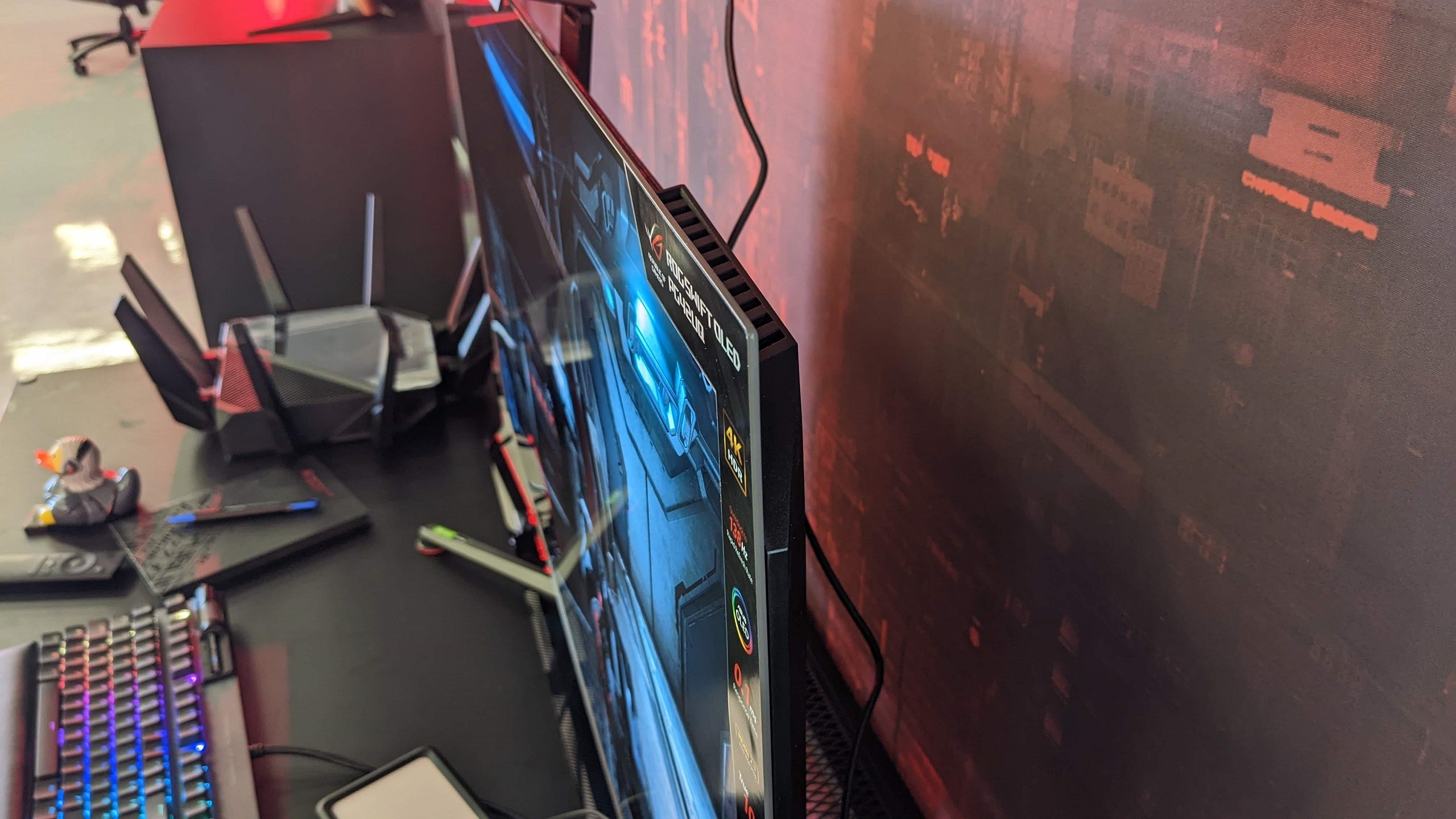Products You May Like
If you’ve drooled over the OLED panel in your phone or TV and decided you’d like the same tech for your PC games, you basically have the choice of a single model each from Gigabyte and Alienware. Asus, then, are about to increase the number of OLED gaming monitors on the market by 100%, with the ROG Swift PG48UQ and ROG Swift PG42UQ. And I’ve just had a brief, but generally impressive, play around with them.
OLED, if you’re not familiar, differs from more widely-used LCD panel types (including the IPS type used by most of the best gaming monitors) in that it’s self-emitting. An OLED panel is based around a thin layer of electroluminescent organic compound that lights up when a current is applied to it – whereas LCD screens use a bulky backlighting system to produce images, this organic compound layer can directly light up each sub-pixel itself. Or simply turn them off by removing the current, for perfect blacks. Usually, this means OLED displays have high response times, better contrast and finer lighting control than LCDs, and are thinner (with smaller bezels) to boot.
I didn’t have my colour calibrator to hand, so haven’t taken very scientific measurements of the ROG Swift PG48UQ and PG42UQ. But pretty much all of the qualities you’d associate with OLED were on, and apologies for the word choice, display. Both are incredibly vibrant monitors, without a hint of haloing or backlight bleed. Because, of course, there isn’t one. On the rear they’re bulked out somewhat by the port housing, dual 10w speakers and 15w woofer, not to mention a dual heatsink system (one downside of OLEDs is their toastiness), but they’re much slimmer around the edges than any other gaming monitor I’ve used.
Both models are 4K, with a maximum refresh rate of 138Hz over DisplayPort 1.4. Which looks odd to my 144Hz-accustomed brain, but comes close enough. Taking advantage of these specs will naturally demand one of the best graphics cards, though playing the likes of Halo Infinite and MotoGP 22 suggested these monitors can keep up on speed too. Motion is slick and ghosting-free, a particular relief given how my OLED TV at home tends to scramble the pixels on fast-moving objects. None of that here, thankfully.

Nvidia G-Sync works pretty too (AMD FreeSync is also compatible), and while I couldn’t measure the screen brightness, both the ROG Swift PG48UQ and PG42UQ can supposedly hit up to 900cd/m2. That’s promising for HDR-supporting games, and in conjunction with OLED’s natural ability to create perfect, inky blacks, contrast looks good too. The contrast ratio, also according to Asus, is 1000000:1, or about 2500 times higher than a decent IPS monitor.
And the best part is they’re so affordabahhhh just kidding. There’s no confirmed release date beyond “soon” but you can expect to pay £1500 for the 48in PG48UQ or £1400 for the PG42UQ, which in the current economic climate is what you might call “I don’t actually want lights or food” money. At any rate they’re pricier than your current OLED options, the £849 Gigabyte Aorus FO48U and the £1099 Alienware AW3423DW, though on paper are generally better-specced as well.

With that in mind, there are even more wealth-withering gaming monitors out there, including Asus’s own £3299 ROG Swift PG32UQX. That uses Mini LED tech that, while still nailed to an IPS panel, is technically newer and more futuristic than OLED. Which makes me wonder – is this OLED’s time to shine? This tech is a step forward over most alternatives, the PG48UQ and PG42UQ convince as proof of its gaming credentials, and TVs and phones have shown that it can get cheaper in time – but at the same time, it’s not bleeding edge, so won’t be the sole reserve of the hyper-enthusiast crowd.
Maybe in a couple of years, OLED gaming monitors will be the go-to choice for anyone willing to spend a bit for optimal picture quality. Suppose we’ll find out eventually – and in the meantime, I’ll be looking to spend a little more quality time with Asus’s efforts. And my calibrator.
